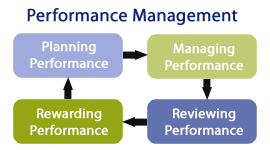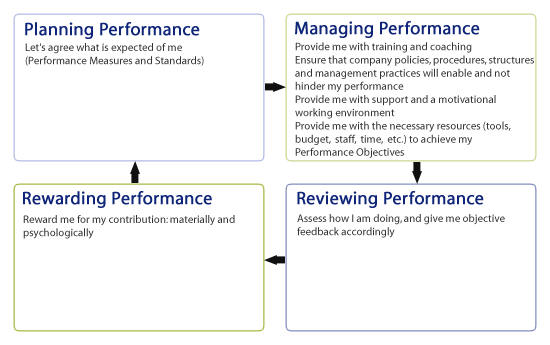| For
more info on our online Performance Appraisal Software
System CLICK
HERE |
| What is Performance Management? |
| Performance Management is a
system and process that link the organization's
goals and strategies to individual and team performance
so as to increase organizational effectiveness. |
| It is a joint process that involves
both line managers and their direct reports ("subordinates")
who jointly identify common goals/objectives which
correlate to the higher goals of the organization.
This process results in the establishment of written
performance expectations (a Performance Agreement)
- later used as measures for feedback and performance
appraisals/reviews. |
| Performance Management is THE
WAY to get OVERALL GRIP on what should be happening
at all levels in an organization, and then measuring
whether it is indeed happening the way intended.
And where this is not materializing, to identify
the cause/s and implement corrective action/s. |
| It is a much wider concept than
the Performance Appraisal/Review. The latter is
only one part of Performance Management (stage 3
in a 4-stage process) |
| Performance Management consists of
FOUR STAGES: |
 |
| This model is aligned with the
WORK NEEDS of individual employees, which are as
follows: |
 |
| To provide for the above needs
of an employee, let's consider what should happen
at each stage of the Performance Management Cycle: |
| 1. Planning Performance:
Performance Measures (Goals, Objectives, Targets,
KPIs, Competencies, etc.) for individual employees
(at all levels) are jointly discussed and agreed
during one-on-one, face-to-face meetings with their
direct line managers. These are put into a formal,
written Performance Agreement for each staff member.
(Performance Agreements can also be drawn up for
entire work teams in organizations where teamwork
is paramount.) |
| 2. Managing Performance:
During this stage, employees implement/execute their
agreed Objectives/KPIs. They manage their own performance,
assisted by line managers who should aim at removing
performance obstacles in the work environment and
providing the necessary resources, training and
coaching. Line managers are also responsible for
integrating and coordinating (horizontally and vertically)
the Objectives/KPIs of all their employees/units/teams,
monitoring their performance, taking corrective
action, and doing joint problem solving as and when
necessary. The leadership, motivation, feedback,
reinforcement and support they need to provide throughout
are of utmost importance. |
| Managing
Performance is an ongoing activity that actually
runs through all phases of the Performance
Management Cycle. It is the Golden Thread
of Performance Management. |
|
| 3. Reviewing Performance:
During formal Performance Appraisal/Review Interviews,
employees and their line managers discuss (and assess)
how well the agreed Objectives/KPIs had been achieved
and specified Competencies demonstrated. Problem
areas are identified and corrective measures put
in place, including possible coaching and training
that the jobholder needs. Depending on the type
of organization and its management philosophy, the
frequency of Performance Appraisals may be any of
1-, 2-, 3-, 4-, 6-, or 12-monthly (Appraisal Smart
caters for all these options). |
| 4. Rewarding Performance:
The actual RATING of performance (how well each
Objective/KPI had been achieved and Competencies
demonstrated) forms part of the Performance Appraisal/Review
Interview. Rewarding people for good performance
takes the form of monetary incentives or rewards
(performance-based pay such as bonuses and/or salary
adjustments). However, the power of non-monetary
rewards, such as praise and recognition, should
not be ignored and need to enjoy much more emphases
than it generally does. |
| It is important to note
that Performance Management is not an additional
responsibility for line managers. Rather, it should
be seen as an EFFECTIVE WAY of managing. In fact,
managing employee performance in the way described
above, is the essence of a manager's job, and not
something that keeps them away from it. |
Crucial
Performance Management Principles
"What gets measured
(monitored, rewarded, emphasized) gets done"
"What you don't
measure, you can't (effectively) manage"
|
|
|
| The most important objectives
and benefits of having a sound Performance Management
System in place: |
| › |
To serve
as the primary vehicle for implementing organizational
goals and strategies (cascaded from top to
bottom throughout the organization). |
| › |
To align and integrate
the goals/objectives and Key Performance Indicators
(KPIs) of the organization vertically and
horizontally through all job categories and
levels, including management. In this way
the entire system works together in pointing
towards the critical bottom line MEASURES,
with bottom line RESULTS generally following
as a matter of course. |
| › |
To facilitate continuous
performance improvement and organization development
- the perfect Change Management and Learning
Organization tool. |
| › |
To achieve quality and
efficiency, i.e. to meet the customer's needs
as precisely, quickly and cheaply as possible. |
| › |
To ensure clarity regarding
work expectations and standards, reducing
jobholder anxiety/stress, resource wastage
and conflict. |
| › |
To continually enhance
employee competence through the identification
of output-related training and development
needs and strategies. |
| › |
To reduce Line Manager
reluctance and fear to do Performance Appraisals
with their staff. |
| › |
To facilitate performance-based
remuneration and rewards, so employees can
see and experience a clear link between their
performance and the rewards they receive. |
| › |
Not only is the existence
of a sound Performance Management and Appraisal
System an OPERATIONAL PREREQUISITE for achieving
organizational goals, but also a LEGAL REQUIREMENT
to prove that proper/due process was followed
(backed by a sound documentation and process
audit trail) when eventually disciplining
-- and especially dismissing -- a staff member
for persistent poor performance. |
|
|
|
